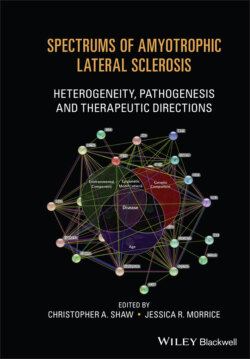Читать книгу Spectrums of Amyotrophic Lateral Sclerosis - Группа авторов - Страница 29
Superoxide Dismutase 1 (SOD1)
ОглавлениеThe first gene in which variants were associated with ALS pathology was superoxide dismutase 1 (SOD1) [3]. First discovered following a polymerase chain reaction (PCR) mutation screening approach of the gene closest to a prior linkage signal, SOD1 variants remained one of the only known genetic causes of ALS for 15 years. Most SOD1 variants lead to a highly penetrant, familial, and dominant presentation of ALS [4], and they are observed in approximately 12% of familial and 1% of sporadic ALS cases [4]. Certain variants (p.D90A, for example) are associated with either dominant or recessive inheritance depending on the population [5, 6]. While SOD1 variants occur in any exon, the frequency of specific SOD1 variants is associated with different ethnicities [5, 7]. For example, SOD1 variants are relatively rare in European cohorts but are the most frequent cause of familial ALS in Asian cohorts [7]. Variant penetrance can be as high as 90–95% by the age of 80 [8], suggesting that the encoded SOD1 protein is intolerant to protein‐altering variants [9] and that most variants are probably associated with familial ALS given sufficient age.
Despite decades of research, the mechanism of SOD1 toxicity in ALS is still not definite. Aggregation of the SOD1 protein is observed with nearly all protein‐altering SOD1 variants [9–11]. Nonetheless, it is uncertain how these SOD1‐positive aggregates are related to the onset and progression of the disease. Variant SOD1 also leads to cell death in the form of excitotoxicity, in which glutamate activity causes prolonged calcium influx and subsequent mitochondrial dysfunction [12]. However, there is evidence that spinal cords with the highest level of SOD1 aggregates are those of longer‐survival ALS [13]. One explanation is that the level of SOD1 aggregates increases in response to normal cellular processes that sequester SOD1 and lower their toxicity. Another potential mechanism for SOD1‐related cell death could be a loss‐of‐function model, in which variants in SOD1 result in a lack of functional SOD1 protein, although such a mechanism has not been convincingly linked to ALS. SOD1 aggregates can recruit wild‐type SOD1 protein [12, 14], leading to a lack of functional SOD1 in the cell. A reduction in SOD1 normal activity, that of a dismutase lowering the number of superoxide radicals, is observed in SOD1 variant carriers [14]. The resulting increase of free radicals in cells has direct negative effects on mitochondrial function and survival. While this observation does not prove that loss of function is the model by which SOD1 variants cause ALS, it does suggest that the mechanism is more complicated than simply SOD1 aggregates causing motor neuron death.
